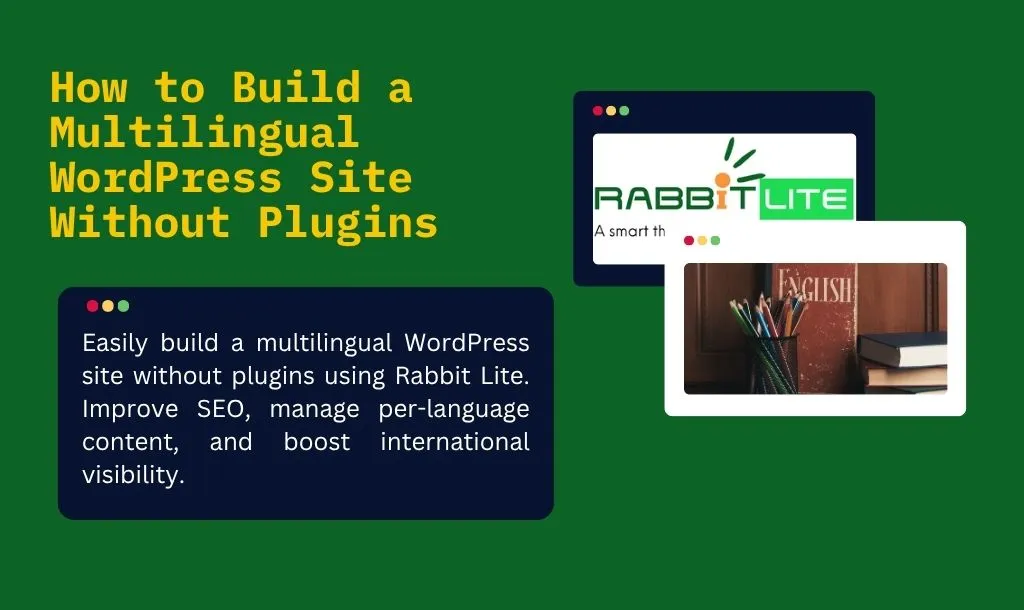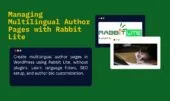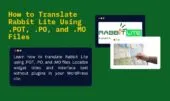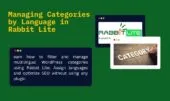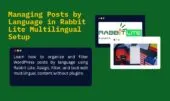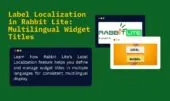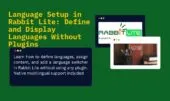- 1. How to Enable Multilingual Support in Rabbit Lite
- 1.1. 🔧 Step-by-Step Guide:
- 1.2. 💡 Tips for Better Multilingual Setup:
- 1.1. What is the benefit of using Rabbit Lite for a multilingual WordPress site?
- 1.2. How can I add new languages in Rabbit Lite?
- 1.3. Does Rabbit Lite include a WordPress language switcher?
- 1.4. Can I build a no plugin multilingual WordPress site with Rabbit Lite?
- 2. Creating Content in Multiple Languages
- 2.1. How do I add language-specific content in Rabbit Lite?
- 2.2. What’s the best way to switch languages without plugins?
- 2.3. Can I optimize multilingual SEO in Rabbit Lite?
- 2.4. Does Rabbit Lite support author pages in multiple languages?
- 3. Multilingual Author Pages and Layout
- 3.1. How to display multilingual author bios?
- 3.2. How to structure author pages for SEO?
- 3.3. Can I use Rabbit Lite without plugins for multilingual authors?
- 3.4. How to switch between author pages in different languages?
- 4. SEO Advantages of a Multilingual WordPress Site
- 4.1. How does multilingual content improve SEO rankings?
- 4.2. How can I set up multilingual SEO without a plugin?
- 4.3. What is the role of the author page in a multilingual WordPress site?
- 4.4. How do I optimize internal linking across languages?
- 5. Language Switcher
- 6. Widget Title Translation Settings
- 7. Common Pitfall: WooCommerce Products Not Filtering by Language
- 7.1. Why this happens:
- 7.2. How to resolve it:
- 8. Using .POT and .MO Files for Language Support
- 9. Common Use Cases
- 9.1. Bilingual personal blog (e.g., Vietnamese + English)
- 9.2. Product showcase website targeting global markets
- 9.3. Local service site supporting Vietnamese – Japanese – Korean
- 9.4. What types of websites benefit most from multilingual setup?
- 9.5. How can I manage three or more languages in Rabbit Lite?
- 9.6. Does multilingual setup slow down WordPress?
- 9.7. Is Rabbit Lite suitable for SEO in multiple languages?
- 10. Tips for Managing Multilingual Content Effectively
- 11. Conclusion
Multilingual websites are essential for reaching users across different regions. In WordPress, this often means relying on third-party plugins to manage translations and content across languages.
However, common plugins like WPML or Polylang can be heavy, introduce compatibility issues, and increase site complexity. For small businesses or personal blogs, this can be an unnecessary burden.
Rabbit Lite offers a built-in multilingual system that eliminates the need for extra plugins. This lightweight solution makes it easier to manage multilingual content while maintaining fast performance. Let’s explore how to enable this feature in Rabbit Lite.
How to Enable Multilingual Support in Rabbit Lite
Setting up a multilingual WordPress site with Rabbit Lite is simple and does not require any third-party plugins. This feature is built directly into the theme to help you manage content in multiple languages efficiently. Whether you’re targeting international readers or optimizing for multilingual SEO WordPress, Rabbit Lite provides native tools to support your strategy.
🔧 Step-by-Step Guide:
- Go to
Rabbit Lite > Settings > Main Settingsand enable the Multilingual option. - After enabling, navigate to
Rabbit Lite > Language. - Click Add New Language and enter the language name (e.g., “English”, “Tiếng Việt”).
- Create posts, pages, and categories specific to each language.
- Define the default language, and optionally convert existing content to match this default.
- Display the WordPress language switcher using menus or theme layout controls.
This setup makes Rabbit Lite a great WordPress theme without plugin dependency for multilingual needs.
💡 Tips for Better Multilingual Setup:
- Use native language names in the menu for better UX.
- You can manage multilingual author pages and assign posts to specific languages.
- For SEO, ensure each translated page has a unique meta title and description.
What is the benefit of using Rabbit Lite for a multilingual WordPress site?
Rabbit Lite offers built-in support for multiple languages without needing extra plugins:
- Reduces load time and improves performance.
- Seamless integration with WordPress core features.
- Helps implement SEO for multilingual WordPress with ease.
How can I add new languages in Rabbit Lite?
To manage multiple languages, use the Rabbit Lite Language panel:
- Go to
Rabbit Lite > Language. - Click Add New and provide a name for the language.
- Assign content or authors to that language.
Does Rabbit Lite include a WordPress language switcher?
Yes. The built-in language management tool includes a switcher option:
- You can insert the switcher into menus or custom layouts.
- It respects the selected language and redirects accordingly.
Can I build a no plugin multilingual WordPress site with Rabbit Lite?
Absolutely. Rabbit Lite is designed to work without third-party plugins:
- Native multilingual support in theme settings.
- Full compatibility with SEO settings per language.
- Works with WordPress multilingual author page assignments.
Creating Content in Multiple Languages
Building a multilingual WordPress site requires more than just switching languages—it involves structuring your content clearly in each language. Rabbit Lite supports this by allowing you to manage translated posts and pages manually, keeping full control over language content while using a WordPress theme without plugin dependencies.
To make the most of Rabbit Lite multilingual capabilities, follow these practical steps:
- Create a duplicate post or page for each language version you need.
- Label each version using a custom field or post tag (e.g.,
lang=en,lang=fr) to organize language-specific content. - Use custom menus to link language versions together. You can create a header or top bar menu for language switching.
- Apply conditional logic via template files to display only content in the current selected language.
- Manually translate metadata such as SEO titles, meta descriptions, and image alt texts to optimize multilingual SEO WordPress performance.
- Organize author content for different languages using the author archive system to simulate a WordPress multilingual author page.
This approach aligns with no plugin multilingual WordPress practices and gives full flexibility to tailor your site’s language experience. It also supports SEO for multilingual WordPress setups by avoiding duplicated or mixed-language content.
How do I add language-specific content in Rabbit Lite?
To publish posts in different languages without plugins:
- Create a new post for each language.
- Add a language tag or prefix in the post title (e.g., “About Us [FR]”).
- Set a canonical URL in the SEO settings to point to the main version.
- Link between language versions using manual navigation.
This approach works well for a multilingual WordPress site built with Rabbit Lite.
What’s the best way to switch languages without plugins?
Rabbit Lite supports a basic WordPress language switcher using menus:
- Create a custom menu item for each language (e.g., English, Spanish).
- Link each to the corresponding language version of your content.
- Add this menu to the top bar or header area using the Rabbit Lite language settings.
This helps create a smooth user experience on a WordPress theme without plugin usage.
Can I optimize multilingual SEO in Rabbit Lite?
Yes. You can follow multilingual SEO WordPress practices manually:
- Use unique SEO titles and descriptions for each language.
- Set hreflang tags if managing them via custom code.
- Avoid automatic translation tools that produce duplicate or low-quality content.
- Organize translated URLs consistently.
All these can be done within Rabbit Lite without relying on external plugins.
Does Rabbit Lite support author pages in multiple languages?
While there’s no automatic integration, you can simulate a WordPress multilingual author page:
- Assign different authors to posts in different languages.
- Customize the author bio section to indicate language context.
- Use category filters or tags to group content by language and author.
This method aligns with the Rabbit Lite multilingual structure and keeps your WordPress site organized and SEO-friendly.
Multilingual Author Pages and Layout
Displaying author pages in multiple languages is essential for building a multilingual WordPress site, offering personalized and SEO-friendly content for readers across different regions. In Rabbit Lite, you can simulate multilingual author pages without relying on external plugins by taking full control of the layout and template structure.
Rabbit Lite supports a plugin-free WordPress theme approach, meaning all multilingual logic must be handled manually using WordPress core features and Rabbit Lite’s language settings. This method delivers faster performance, lower complexity, and greater SEO flexibility.
This approach aligns with a no-plugin multilingual WordPress strategy, giving you full control and optimized performance—especially when using a lightweight theme like Rabbit Lite.
How to display multilingual author bios?
To personalize each author’s profile for a specific language:
- Edit each author’s bio and write it in the target language.
- Use tags or metadata to group language-specific posts.
- Ensure the display template respects the current language using conditional PHP.
This approach keeps your WordPress multilingual author page accurate and localized.
How to structure author pages for SEO?
For multilingual SEO WordPress optimization:
- Use the Biographical Info field to write a language-specific author description. A part of this text will be used as the SEO meta description.
- Set a custom SEO Title for each author page in the corresponding language to improve title relevance in search results.
- These fields can be edited directly from the author’s profile page in the WordPress admin panel.
These practices improve search engine visibility by ensuring that each author page is properly localized and optimized for its target language.
Can I use Rabbit Lite without plugins for multilingual authors?
Yes. With Rabbit Lite multilingual structure:
- You can avoid plugin dependencies entirely.
- Use WordPress author roles to organize language-specific authors.
- Combine with Rabbit Lite language settings for layout control.
This ensures your WordPress theme without plugin stays lightweight and efficient.
How to switch between author pages in different languages?
To implement a WordPress language switcher for author pages:
- Change the language using the language switcher menu, typically placed in the site header or navigation bar.
- Redirect users to the corresponding author page in the selected language. Each language version should link to the appropriate author profile for that language.
- Ensure that author data, such as biography and assigned posts, matches the selected language context.
This approach enables smooth language switching across author pages and enhances the multilingual experience without relying on translation plugins.
SEO Advantages of a Multilingual WordPress Site
Expanding your content into multiple languages significantly improves your visibility on search engines. A multilingual WordPress site gives you access to regional keyword opportunities, reduces bounce rates, and helps build audience trust by serving content in their native language. With Rabbit Lite multilingual settings, you can implement this without relying on heavy translation plugins.
Here are the key SEO benefits and how to implement them effectively:
- Reach more audiences through localized search results
When users search in their native language, your translated content will appear, increasing traffic and engagement. - Improve multilingual SEO for WordPress by optimizing meta tags per language
Use Rabbit Lite language settings to add unique SEO titles, meta descriptions, and keywords for each version of the post or page. - Reduce bounce rate and improve session duration
Visitors stay longer when content is easy to understand, which is critical for SEO signals. - Support country-specific SERPs (Search Engine Results Pages)
With a multilingual WordPress site, you can target country-specific Google results, improving your global presence. - No-plugin multilingual WordPress setup with clean HTML output
Rabbit Lite supports language customization directly in the theme, making it a lightweight solution for multilingual SEO WordPress needs. - Enhance internal linking and content relevance
Use multilingual author pages and language-specific navigation to improve crawlability and keyword density across language versions.
How does multilingual content improve SEO rankings?
Adding multilingual content gives you new opportunities to rank on localized Google versions.
- Each translated post increases your total indexed pages.
- You can target specific regional keywords in each language.
- Search engines reward content that meets user intent across languages.
How can I set up multilingual SEO without a plugin?
Rabbit Lite provides theme-level controls to configure multilingual support.
- Use Rabbit Lite language settings to assign translations per post.
- Customize meta tags and Open Graph data manually.
- Add a custom WordPress language switcher via shortcode or menu.
What is the role of the author page in a multilingual WordPress site?
The multilingual author page helps build trust and shows topic authority in each language.
- You can assign language-specific bios and content.
- Improve keyword targeting per author-language combination.
- Boost SEO by linking to relevant translated posts.
How do I optimize internal linking across languages?
Internal links should point to the corresponding language version to help users and search engines.
- Use translated slugs or custom permalinks for clarity.
- Include a language switcher for each content type.
- Ensure canonical URLs are correctly set per language.
Language Switcher
The Rabbit Lite language switcher is automatically added to the topbar menu when multilingual mode is enabled. It allows visitors to switch between language versions easily without the need for additional plugins.
- Automatically integrated into the topbar menu once multilingual support is turned on.
- When a user selects a different language, the site content—including menus, posts, and metadata—will switch to the corresponding language.
- Fully supports manual linking between translated versions of each page or post.
- Designed for performance: no external requests or plugin overhead.
Widget Title Translation Settings
Translating widget titles is essential for maintaining a consistent multilingual experience across your WordPress site. In Rabbit Lite, this can be done manually with full control:
- Go to
Rabbit Lite > Label Localization. - Create separate widgets for each language version.
- Use language-specific labels such as “[EN] Latest Posts”, “[VI] Bài viết mới”, etc.
- Combine this with language-based display logic or visibility filters if available.
- This method ensures widget areas like sidebars and footers remain relevant and readable for each audience segment.
Common Pitfall: WooCommerce Products Not Filtering by Language
When using Rabbit Lite to build a multilingual WordPress site without plugins, some users notice that WooCommerce product widgets display items in all languages, regardless of the current language selected. This usually happens when the widget attempts to apply automatic language-based filtering, but the product data hasn’t been structured with per-language separation.
Why this happens:
- Rabbit Lite applies language filtering automatically in most widgets.
- However, WooCommerce products often share the same global data unless additional separation is configured.
How to resolve it:
If your products are shared across languages or you want to manually manage multilingual product visibility:
- Go to Rabbit Lite > Widget Settings in the WordPress admin.
- Locate the WooCommerce product widget (e.g., “Products”, “Featured Products”, etc.).
- Enable the option “Skip multi-language filter” for that widget.
This tells Rabbit Lite not to auto-filter the widget content by language, allowing you full control over what gets displayed — especially useful if you’re handling multilingual products manually or through custom taxonomies.
Using .POT and .MO Files for Language Support
Rabbit Lite supports WordPress-standard translation through .POT, .PO, and .MO files, allowing you to manage multilingual text (including widget titles) efficiently:
- Use a tool like Poedit to generate
.POand.MOfiles from the theme’s.POTfile. - Locate the
.POTfile in the/languages/folder of the Rabbit Lite theme. - Translate all interface strings, including widget titles, and save them as
rabbit-lite-en.mo,rabbit-lite-vi.mo, etc. - Upload the
.MOfiles to the same/languages/directory. - WordPress will automatically load the correct translation based on the active site language.
This approach ensures language consistency across all theme-generated strings and works seamlessly with manual widget management
Common Use Cases
When building a multilingual WordPress site, it’s important to consider the most practical scenarios where language diversity brings measurable benefits. With Rabbit Lite’s built-in language support, you can execute common multilingual strategies without needing a plugin, keeping your site light and fast. Below are real-world examples and how to implement them using Rabbit Lite multilingual tools:
Bilingual personal blog (e.g., Vietnamese + English)
- Use the
Rabbit Lite Languagepanel to add both languages. - Create separate posts per language and interlink them manually.
- Optimize each post using language-specific metadata for better SEO for multilingual WordPress.
Product showcase website targeting global markets
- Add English, French, or Spanish content directly within Rabbit Lite settings.
- Avoid plugin complexity with the no plugin multilingual WordPress structure.
- Translate SEO tags and media alt texts for improved multilingual SEO WordPress rankings.
Local service site supporting Vietnamese – Japanese – Korean
- Add multiple Asian languages in the built-in language manager.
- Use top bar language switcher to help users navigate intuitively.
- Assign authors per language to simulate a WordPress multilingual author page.
These use cases highlight how flexible Rabbit Lite is for multilingual needs while preserving performance and avoiding unnecessary plugin dependencies.
What types of websites benefit most from multilingual setup?
A multilingual configuration is ideal for expanding content reach and serving diverse audiences.
- Personal blogs with bilingual content (e.g., travel, cooking).
- Corporate or startup websites targeting different markets.
- Local businesses catering to international customers or tourists.
How can I manage three or more languages in Rabbit Lite?
Handling multiple languages is possible without plugins.
- Add each language using
Rabbit Lite > Language. - Create and tag content manually for each language.
- Use the menu system as a WordPress language switcher.
Does multilingual setup slow down WordPress?
Not in Rabbit Lite.
- Built-in tools ensure lightweight performance.
- No extra plugin overhead.
- Page speed remains high due to the optimized codebase.
Is Rabbit Lite suitable for SEO in multiple languages?
Yes, it supports practical multilingual SEO WordPress features.
- Set meta descriptions per language.
- Use unique slugs and titles.
- Improve keyword targeting and avoid content duplication.
Tips for Managing Multilingual Content Effectively
Managing a multilingual WordPress site effectively means going beyond translation—it involves careful SEO planning, content structure, and performance control. Rabbit Lite provides the flexibility to do this without relying on external tools.
- Keep URLs short and avoid translating slugs unless needed. A clean URL is easier for both users and search engines.
- Audit SEO content per language, including title, meta description, Open Graph data, and schema to improve multilingual SEO WordPress performance.
- Use country-specific keywords to target local search behaviors. Research the most relevant terms in each target language.
- Avoid mixed-language pages, which can confuse search engines and lower ranking.
- Test language variations in Google Search Console to see how content ranks per country.
- Use hreflang tags (if managing manually) to signal language targeting to search engines.
These practices help ensure your no plugin multilingual WordPress setup remains optimized for both usability and visibility.
Conclusion
Rabbit Lite enables you to create a lightweight, efficient multilingual website without relying on third-party plugins. This is especially useful for bloggers, small businesses, and web creators who want full control over multilingual content without sacrificing speed or budget.
With customizable SEO per language, a built-in language switcher, and flexible display options for each author or content section, Rabbit Lite is a practical choice for building a multilingual WordPress site optimized for both performance and user experience. You not only save on plugin costs, but also maintain clean, fast, and maintainable code.
From content structure and display to multilingual SEO, everything is handled manually yet effectively—thanks to the minimalist and purposeful design of Rabbit Lite.

